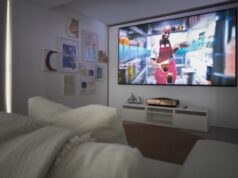
Lighting can make or break a home theatre. Too much, and it washes out the screen. Too little, and you’re fumbling in the dark. The right lighting strikes a perfect balance—subtle, stylish and practical—enhancing the mood without stealing the spotlight.
Here’s how to get your home theatre lighting just right.
Start with a dark base
A good home theatre starts with a darkened room. Light-coloured surfaces reflect ambient light, which reduces contrast and clarity on screen. For best results, paint walls and ceilings in dark, matte tones and use furnishings that absorb light.
Pair this with soundproofed walls and insulated plasterboard to reduce external noise and create a focused, cinema-like environment.
Use layers of light
The best home theatre lighting uses a layered approach. Instead of a single overhead fixture, combine multiple light sources to create ambience and flexibility:
- Ambient lighting: The base layer that softly lights the entire room. Use dimmable downlights or concealed LED strips for a low-glare effect.
- Accent lighting: Highlights architectural features or adds visual interest. Think wall sconces or backlit panels.
- Task lighting: Useful for reading or navigating the room. Small table lamps or low-level step lights work well here.
- Decorative lighting: Adds style. Neon signs, LED starlight ceilings or colour-changing strips can give your theatre a custom touch.
All lights should be dimmable, preferably via a central control or smart system. This lets you adjust brightness based on what you’re watching, whether it’s a matinee or a midnight horror flick.
Avoid direct light on the screen
Glare is the enemy of immersion. Avoid placing lights directly above or in front of the screen, and be mindful of reflections on glossy surfaces.
Recessed ceiling lights or wall sconces aimed upward or downward are ideal. You can also install perimeter LED strip lighting around the ceiling or under seating platforms for a soft glow that doesn’t interfere with viewing.
If your home theatre includes windows, block out natural light completely with heavy curtains or blinds. Blackout materials are essential for daytime screenings.
Consider automation
Smart lighting systems allow you to control brightness, colour temperature and timing—all from your phone or remote. You can even program “movie modes” that dim the lights as your movie starts, then gently bring them back up when it ends.
For new builds or major renovations, integrate lighting control into your overall home automation setup to control blinds, AV equipment and lighting all from one hub.
Add pathway and safety lighting
If you’re including raised platform seating, be sure to add step lighting or low-level LEDs along the base. This provides a safe footing without flooding the room with light.
Wall-mounted sconces with downward-facing beams are another great way to light hallways or entry points into the room.
Lighting tips for renovators
- Retrofit with care: If you’re updating an existing space, use surface-mounted fittings or LED strips to avoid rewiring.
- Test placements: Use temporary lights to test for screen glare before final installation.
- Dimmers are essential: Replace standard switches with dimmers for precise control.
Lighting your home theatre isn’t just about visibility—it’s about creating mood, enhancing comfort and supporting a true cinematic experience. With the right setup, you’ll watch in total immersion, not distraction.





